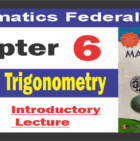Prove Arc Length Formula l = rθ
Prove Arc Length Formula l = rθ is an important topic of 9th math chapter 6 trigonometry. The arc length formula is one of the fundamental concepts in geometry and trigonometry, widely used in mathematics, physics, and engineering. This formula states that the length of an arc (L) in a circle is the product of the radius (r) and the central angle (θ) measured in radians:
In this blog post, we will explore the derivation of this formula, understand its significance, and look at its real-world applications.
Understanding the Arc Length Formula Before proving the formula, let’s break down the key components:
- Arc Length (l): Part of circumference of circle is called an arc.
- Radius (r): The fixed distance from the centre of the circle to any point on its circumference.
- Central Angle (θ): The angle subtended at the centre of the circle by an arc, measured in radians.
The concept of radians is crucial in deriving this formula. Unlike degrees, which divide a circle into 360 equal parts, radians measure angles based on the arc length.
What is a Radian?
A radian is defined as an angle subtended at the centre of a circle by an arc whose length is equal to the radius of the circle.Mathematically:
Derivation of the Arc Length Formula
To derive the arc length formula, consider the following steps:
- Full Circle Case:
- The total circumference of a circle is given by: C = 2π r
- This corresponds to a central angle of 2π radians.
- Proportion for Any Angle (θ):
- The arc length should be proportional to the fraction of the full circle it subtends.
- Since θ radians is a fraction of 2π radians, the arc length is given by:
Thus, we derive the formula:
l/C = θ / 2π
or l= θ / 2π (C )
= θ / 2π (2π r )
or l = rθ
This equation shows that the arc length is directly proportional to both the radius and the central angle.
Applications of the Arc Length Formula
Mathematics: Essential for solving geometry and trigonometry problems involving circles and curves.
Physics: Used in kinematics and rotational motion to determine distances traveled along curved paths.
Engineering: Applied in designing roads, gears, and mechanical components that involve circular motion.
Astronomy: Helps calculate the angular displacement of celestial bodies in their orbits.
Example Problems
Example 1: Finding Arc Length
A circle has a radius of 10 cm. If the central angle is 2 radians, find the arc length.
Solution:
Example 2: Finding the Central Angle
An arc of 15 cm is formed in a circle with a radius of 5 cm. Find the central angle in radians.
Solution: l = rθ
l = (10) (2) = 20 cm
Conclusion
The arc length formula is a fundamental concept in geometry, providing a simple yet powerful way to measure curved distances in circles. Understanding this formula and its applications can help in solving real-world problems in various scientific and engineering fields.
By practicing different problems and applying the concept in practical situations, you can strengthen your understanding and build a strong foundation in geometry.
Check! Some important links below




